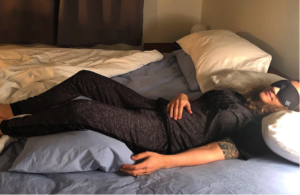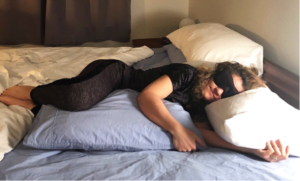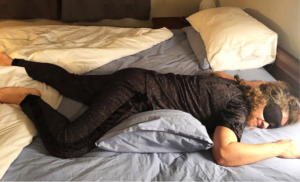Tossing? Turning? Can’t sleep because you have back pain? How frustrating. Sleep is where you go to rest, rejuvenate and feel restored. When you can’t sleep or have to sleep in a very specific position to avoid your back aching or spasming you can feel depleted and defeated by the time the morning comes. Exhausting. Now let’s try functioning for the whole day after that. Yah, right!
Contributing Factors
Back pain when sleeping is very specific to each individual.
Some questions asked to help find out the “why”:
- How old is your mattress? An old mattress (over 7 – 10 years for a high end depending on care) is like a worn out pair of shoes. It can cause poor support when sleeping. Pillows can be a friend or foe, as well (replace after about 1 year). Make sure they suit your level of supported needs (size, shape, texture…).
- Is there a known injury or a pathology? Disc herniation, scoliosis, arthritis? Although these conditions are not curable you can stretch and strengthen to support your body and minimize any painful symptoms. A healthcare professional can design a program specific to your needs.
- What is your sleep position? What/Who are you sharing your space with? I get a kick out of patients that tell me they sleep with their pets that “take up all the bed”. I get it. I did the same with Chester our big slab of lab. He was a bed hog! He sure was sweet and cuddly though – RIP. Should we talk about the cat, partner and kids as well? You see where I am going with this.
Sleeping Position
General rule: Posture with standing and sitting is just as important when sleeping. Your target is to support the natural curves in your spine. Your pillow should be under your head and neck – not your shoulders. Roll like a log, instead of segmentally, to avoid twisting your spine or pull your knees up to your chest and move.

Back sleepers: A pillow under your knees can help unload your low back. It can shorten tight hip flexors which are attached to your lumbar spine pulling on your back when your legs are straight. This helps to soften things up.

Side sleepers: Support your spine! Try aligning your spine from your neck to lower back. A pillow under the head that keeps your neck straight, one in front of your body and between your knees to avoid twisting.

Stomach sleepers: Pillow up under your stomach to take the stress of extending your back. Your head pillow should be thin or perhaps none at all. The spine does not like bending backwards for long periods of time.
My first go to, though, is have a professional check out what might be going on. It’s important to get to the root of a problem and figure out solutions that are specific to your needs. Back pain when sleeping is diverse and it doesn’t have to be “just the way it is”. And if it is, your healthcare team can find ways to best support you and your individual needs.
Our experienced team of movement therapists at Reformotiv are here to address all of your individual concerns and goals. We will work with you to restore your personal quality of life.
Book in now to learn more about what you can do to combat those nightly aches and pains, how to reboot a restful sleep routine, and how to maximize your daytime energy!

